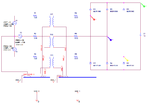TripACT
Member level 3
I built a three-phase rectifier using 6 diodes (full wave rectifier), feeding from a three-phase transformer 400v line-to-line to 24v dc.
To filter out the result i'd use a filtering circuit. At first i'd guess an electrolytic capacitor connected on the output should sufficient.
I tried different ranges C but nothing could perform better than this.
I'm trying to figure how to improve the DC filtering to smooth out the result as much as possible.
Is there any better way to do it ?
Please note:
I don't want to use 6 phase rectifier.
The idea is to feed that 24V right into a BUCK Converter obtaining high efficiency.
The design is made with OrCAD Capture & PSPice A/D Simulation
Any help appreciated !
Gary


To filter out the result i'd use a filtering circuit. At first i'd guess an electrolytic capacitor connected on the output should sufficient.
I tried different ranges C but nothing could perform better than this.
I'm trying to figure how to improve the DC filtering to smooth out the result as much as possible.
Is there any better way to do it ?
Please note:
I don't want to use 6 phase rectifier.
The idea is to feed that 24V right into a BUCK Converter obtaining high efficiency.
The design is made with OrCAD Capture & PSPice A/D Simulation
Any help appreciated !
Gary


Last edited:
